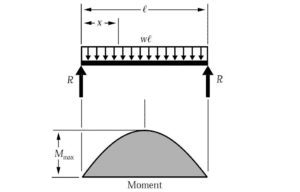Bending Moment – its 2 [ Types & Stresses ]
When the external force is applied to the object, the reaction occurs (In the structure), which forces the thing to bend, is known as Bending Moment. It is a reaction induced in a structural element by the moment and moves the piece to turn. The simplest structural member who mainly faces the bending moment is the Beam. In short form, it is termed BM.
In supported beams, the bending moment is maximum at the mid of the beam span and minimum or zero at the end support of the Beam. It is measured in (kNm).
In Beam, the different types of bending moments occur in other sections of the span. For example, in supported (UDL) beams, the moment is maximum at the mid and decreases toward the ends, and becomes zero when it reaches the support.

Different types of Moments
- Hogging (Negative)
- Sagging (Positive)
Hogging:
The hogging is also called a negative moment and defines a beam that curves upward in the middle direction.
- Mainly occur in cantilever beams.
- In a multi-span continuous beam, this moment occurs at its intermediate supports.
- This one side moment is anti-clockwise (L.H.S), and the other side is the clockwise direction (R.H.S).
![Bending Moment - its 2 [ Types & Stresses ] 1 hogging](https://www.civilclick.com/wp-content/uploads/2019/03/hogging-300x106.png)
Sagging:
The sagging moment is also known as a positive moment. The bending moment is an essential factor that should be considered and calculated when designing a beam.
The bending moment forces the member to bend in simple words due to an external or internal moment. It can be calculated as the perpendicular force-multiplying by the distance from the force. If the tensile stresses are more significant than the yield stresses, then a failure in bending will occur. When points are applied on the beam, the beams deform, and this deformation is called bending of a beam due to the shear force and bending moment. These stresses are produced due to bending is called flexure stresses.
![Bending Moment - its 2 [ Types & Stresses ] 2 sagging](https://www.civilclick.com/wp-content/uploads/2019/03/sagging-300x151.jpg)
Point of Contraflexure:
In beams, a point of zero or minimum bending moment is a point of contra flexure. It is a location where the no bending moment will occur or where BM changes its sign is called a point of contra flexure.
![Bending Moment - its 2 [ Types & Stresses ] 3 point of contraflexure](https://www.civilclick.com/wp-content/uploads/2019/03/photo-25-min-min-300x173.jpg)
Types of bending stresses in beams:
1.Pure bending stresses:
When the bending occurs solely because of coupling on its ends, it is called pure bending. In pure bending stresses, the no shear force strains are produced in a beam, But the everyday stress should be built in this case. The normal stress causes failure to beam.
![Bending Moment - its 2 [ Types & Stresses ] 4 pure bending moment](https://www.civilclick.com/wp-content/uploads/2019/03/Pure-Bending-e1438735490786-min-300x108.jpg)
2.Simple bending stress:
Bending will occur due to the self-load and external load of the beam. It is called simple bending stress. Both shear force stress and everyday stress are produced in simple bending stress. It is also known as ordinary bending.
![Bending Moment - its 2 [ Types & Stresses ] 5 simple bending moment](https://www.civilclick.com/wp-content/uploads/2019/03/Simple-Bending-e1438735607430-min-300x111.jpg)
Result both shear and bending stresses.
Read Also:
We Love CricketAdd a Comment
You must be logged in to post a comment.

amazing information .thank you for sharing.